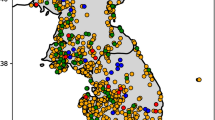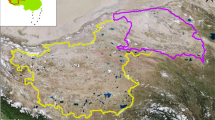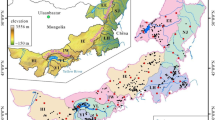Abstract
Lake area is an important indicator for climate change and its relationship with climatic factors is critical for understanding the mechanisms that control lake level changes. In this study, lake area changes and their relations to precipitation were investigated using multi-temporal Landsat Thermatic Mapper (TM) and Enhanced Thermatic Mapper plus (ETM+) images collected from 10 different regions of Mongolia since the late 1980s. A linear-regression analysis was applied to examine the relationship between precipitation and lake area change for each region and across different regions of Mongolia. The relationships were interpreted in terms of regional climate regime and hydromorphological characteristics. A total of 165 lakes with areas greater than 10 hm2 were identified from the Landsat images, which were aggregated for each region to estimate the regional lake area. Temporal lake area variability was larger in the Gobi regions, where small lakes are densely distributed. The regression analyses indicated that the regional patterns of precipitation-driven lake area changes varied considerably (R 2=0.028–0.950), depending on regional climate regime and hydromorphological characteristics. Generally, the lake area change in the hot-and-dry Gobi regions showed higher correlations with precipitation change. The precedent two-month precipitation was the best determining factor of lake area change across Mongolia. Our results indicate the usefulness of regression analysis based on satellite-derived multi-temporal lake area data to identify regions where factors other than precipitation might play important roles in determining lake area change.
Similar content being viewed by others
References
Batima P, Natsagdorj L, Gombluudev P, et al. 2005. Observed climate change in Mongolia. AIACC Working Paper, 12: 5–20.
Castaneda C, Herrero J, Casterad, M A. 2005. Landsat monitoring of paya-lakes in the Spanish Monegros desert. Journal of Arid Environments, 63: 497–516.
Chavez P S Jr. 1996. Image-based atmospheric corrections-revisited and improved. Photogrammetric Engineering and Remote Sensing, 62(9): 1025–1036.
Chuluun T, Altanbagana M, Tserenchunt B. 2010. Land degradation and desertification in Mongolia. Background paper for Mongolian Human Development Report, Ulaanbaatar, Mongolia.
Cretaus J F, Birkett C. 2006. Lake studies from satellite radar altimetry. Comptes Rendus Geoscience, 338: 1098–1112.
Cretaus J F, Jelinski W, Calmant S, et al. 2011. SOLS: A lake database to monitor in the Near Real Time water level and storage variations from remote sensing data. Advances in Space Research, 47: 1497–1507.
Davaa G, Mijiddory R, Khudulmur S, et al. 2005. Responses of the Uvs lake regim to the air temperature fluxtuations and the environment changes. In: Proceedings of the Fist International Symposium on Terrestrial and Climate Change in Mongolia. Ulaanbaatar, Mongolia, 130–133.
Davaa G, Oyunbaatar D, Sugita M. 2006. Surface water of Mongolia. In: Environmental Book of Mongolia. Tokyo, Japan, 55–82.
Dietz A J, Amgalan E, Erdenechuluun T, et al. 2005. Carrying capacity dynamics, livestock commercialization and land degradation in Mongolia’s free market era. Poverty Reduction and Environmental Studies, Vrije University, the Netherlands.
Erdenetuya M, Khishigsuren P, Davaa G, et al. 2006. Glacier change estimation using Landsat TM data. International Archives of the Photogrammetry, Remote Sensing and Spatial Information Science, 36, Part 6, Tokyo.
Igarash Y, Inomata Y, Aoyama M, et al. 2009. Possible change in Asian dust source suggested by atmospheric anthropogenic radionuclides during the 2000s. Atmospheric Environment, 43: 2971–2980.
Johnson D A, Sheehy D P, Miller D, et al. 2006. Mongolian rangelands in transition. Secheresse, 17: 133–141.
Kawata Y, Ohtani A, Kusaka T, et al. 1990. Classification accuracy for the MOS-1 MESSR data before and after the atmospheric correction. IEEE Transactions. Geoscience and Remote Sensing, 28: 755–760.
Kim J. 2008. Transport routes and source regions of Asian dust observed in Korea during the past 40 years (1965–2004). Atmospheric Environment, 42: 4778–4789.
Komatsu G, Brantingham P J, Olsen J W, et al. 2001. Paleoshoreline geomorphology of Boon Tsagaan Nuur, Tsagaan Nuur and Orog Nuur: the Valley of Lakes, Mongolia. Geomorphology, 39: 83–98.
Lillesand T M, Kiefer R W, Chipman J W. 2004. Remote sensing and image interpretation, 5th edition. USA, John Willey & Sons, 574–575.
Liu H J, Zhou C H, Cheng W M, et al. 2008. Monitoring sandy desertification of Otindag Sandy Land based on multi-date remote sensing images. Acta Ecologica Sinica, 28(2): 627–635.
Liu J, Wang S, Shumei Y, et al. 2009. Climate warming and growth of high-elevation inland lakes on the Tibetan Plateau. Global and Planetary Change, 67: 209–217.
Ma R H, Duan H T, Hu C M, et al. 2010. A half-century of changes in China’s lakes: global warming or human influence? Geophysical Research Letters, 37: L24160, doi: 10.1029/2010GL045514.
Nadintsetseg B, Shinoda M. 2011. Seasonal change of soil moisture in Mongolia: its climatology and modeling. International Journal of Climatology, 31: 1143–1152.
Nakayama Y, Yanagi T, Yamaguchi S, et al. 2007. Monitoring of environmental change in Dzungar Basin by the analysis of multi- temporal satellite data sets. Advances in Space Research, 39: 52–59.
Natsagdorj L, Jugder D, Chung Y S. 2003. Analysis of dust storms observed in Mongolia during 1937–1999. Atmospheric Environment, 37: 1401–1411.
Neupert R F. 1996. Population, nomadic pastoralism and the environment in the Mongolian Plateau. Population and Environment, 20: 413–441.
Romanovsky V V, Tashbaeva S, Crétaux J F. 2013. The closed Lake Issyk-Kul as an indicator of global warming in Tien-Shan. Natural Science, 5(5): 608–623.
Saizen I, Maekawa A, Yamamura N. 2010. Spatial analysis of time-series changes in livestock distribution by detection of local spatial associations in Mongolia. Applied Geography, 30: 639–649.
Scepan J, Menz G, Hansen M C. 1999. The DISCover validation image interpretation process. Photogrammetric Engineering and Remote Sensing, 65: 1075–1081.
Song C, Woodcock C E, Seto K C, et al. 2001. Classification and change detection using TM data: when and how to correct atmospheric effects? Remote Sensing of Environment, 75: 230–244.
Tsujimura M, Abe Y, Tanaka T, et al. 2007. Stable isotopic and geochemical characteristics of groundwater in Kherlen River basin, a semi-arid region in eastern Mongolia. Journal of Hydrology, 333: 47–57.
UNEP RRC.AP. 2002. State of environment, Mongolia 2002. AIT-UNEP Regional Resource Centre for Asia and Pacific. http://www.rrcap.unep.org/pub/soe/mongoliasoe.cfm.
Yang H, Lee E, Do N, et al. 2012. Seasonal inter-annual variations of lake surface area of Orog Lake in Gobi, Mongolia during 2000–2010. Korean Journal of Remote Sensing, 28: 267–276.
Author information
Authors and Affiliations
Corresponding author
Rights and permissions
About this article
Cite this article
Kang, S., Lee, G., Togtokh, C. et al. Characterizing regional precipitation-driven lake area change in Mongolia. J. Arid Land 7, 146–158 (2015). https://doi.org/10.1007/s40333-014-0081-x
Received:
Revised:
Accepted:
Published:
Issue Date:
DOI: https://doi.org/10.1007/s40333-014-0081-x




